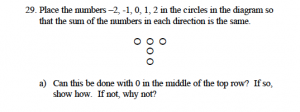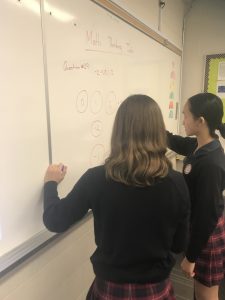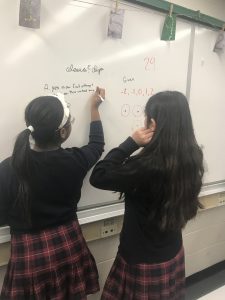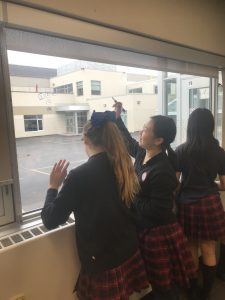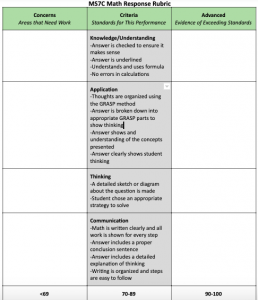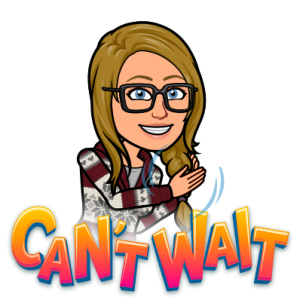This was an absolute week of small and big victories in my math class. To start we are going through an Integers unit and as always certain parts of the concepts completely flummox some of my students . To that end I have a silly dance to help my students remember integer rules. After we had explored and discussed the concepts I showed my students the dance. In the past this has always been something funny but since this is now the age of TikTok my students pounced on it and asked if I would make one for the math dance. I told them I don’t have an account but they were welcome to. Instead I made a silly dance video and posted it to my twitter account @MsGScience2. If you want to see it it’s on my twitter feed and I have to preface by saying I am not a good dancer.
From there, the energy in math class continued. This week we had a guest from the CEMC come in to visit and because of that my 7’s had to move to a different classroom. From some sheer act of luck we were moved to the exact classroom I was able to watch a grade 12 math lesson in that I had reflected on previously. It is chocked full of whiteboards and ‘good math energy’. I walked in to the class and looked around and thought, ‘I can’t waste this opportunity to shake things up’. To that in when my students walked in I informed them we were going to do a surprise thinking task.
I have been keeping my students informed of the professional development I have been working on and told them that this was going to be a fun trial run on what we have been working on as a class. To that end I put up our math response rubric and we looked over it one more time as a class. We discussed if we felt anything should be changed or if our idea of excellence had changed at all. The girls all felt pretty comfortable with the concepts and how they would be assessed. I then paired them up and spread them out throughout the space and presented them with our open ended question.
The girls then dove into the question and used the space to the best of it’s ability
While they were doing this I was able to circulate, discuss and take notes on their observations. I noticed that the girls were thoroughly enjoying themselves and even go to witness a few of these moments.
Afterwards, I sent out an anonymous survey to the students. I hadn’t planned on doing the thinking task with the students yet, but one of the next steps was to send out a survey to see what I could change or do differently next time. The survey would help me see if my students were seeing the results I was and if I was really on the right track for my How Might We question. I told the students that this was an anonymous exit ticket and that any feedback would be useful to me. Since I am focusing on increasing risk-taking and student buy in in my class, my questions had to do with things we did in that specific class as well as how they felt about the assessment itself and the risks they had to take to answer open-ended questions. The first answer about their comfort made me laugh right out loud.
 Most forgot they were even being assessed at all.
Most forgot they were even being assessed at all.
From there I asked them if they felt more comfortable with the risks they took to find answers during this assessment and the answers got me so excited..
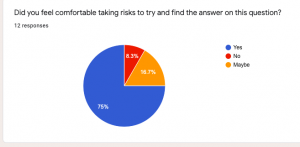
I couldn’t have asked for better progress and I was thrilled to see this and their reflection.
I then asked them to consider the changes we made to the lesson and how they felt about several things; from the rubric to the way we used the room to go through and explore these questions. Overall the students seemed to really appreciate how we
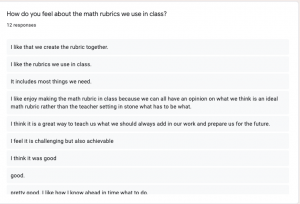
use the rubric, and that they were given the opportunity to discuss and problem solve together in an open and engaging way.
To sum up this week ended with me seeing some real tangible results and progress towards my HMW question, and I was able to see real growth not only in myself as a teacher but also in the mindset of my students and their overall engagement in my math class. I am so excited to take this to another level. I think my next goal should be as mentioned before, to see how I can take this beyond my assessments and to my lessons as a whole. Each day I feel that I am teaching more and more authentically and bringing more to my students. I can’t wait to see where I end up next.

